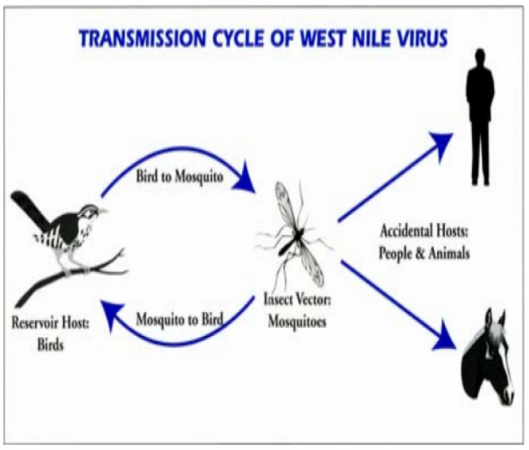West Nile Virus
Overview of West Nile Virus
West Nile Virus is a mosquito borne, zoonotic disease. In the wild, West Nile Virus cycles between birds and mosquitoes. Rarely, a mosquito that has been infected with the virus will bite a human. In most cases, WNV is transmitted to humans by the Culex mosquito species, particularly Culex pipiens1.
WNV requires a mosquito bite to infect a person: it is not spread directly from animals to people or from person to person2. Persons over 50 years old are at higher risk for complications of WNV.
West Nile Virus has no effective treatments, and can be very serious. It is extremely important to prevent infection with the virus by reducing your chances of being bitten by a Culex mosquito. Some ways you can prevent West Nile Virus include removing standing water from around your house, staying inside between dawn and dusk when the mosquitoes are most active and wearing DEET-based mosquito repellant when you are outside.
For more suggestions on preventing mosquito bites, visit our Mosquito-borne Diseases page
West Nile Virus Life Cycle
West Nile Virus circulates in the wild between birds and the Culex mosquito species. A mosquito may become infected with WNV by biting an infected bird, such as a robin3. The virus replicates in the mosquito’s midgut epithelial cells before moving into the salivary glands, where it continues to replicate4. When the host mosquito bites another bird or animal, the virus enters its new host through the saliva. If the new host is a bird, the cycle will begin again. If the new host is a human or another large mammal, the virus will not be able reach a high enough blood concentration to infect another mosquito.

How West Nile Virus Spreads
West Nile Virus can only be transmitted to humans and other animals through a mosquito bite. In Massachusetts, the Culex pipiens mosquito is considered the primary vector of West Nile Virus. This species of mosquito primarily bites birds, however it is also known to occasionally bite humans.
West Nile Virus cannot be spread through coughing or sneezing. It also does not spread from touching or eating infected birds or animals5.
When Do Symptoms Develop?
Symptoms usually start 4 to 10 days after the infecting bite9.
Symptoms of West Nile Virus
Around 80% of people who are infected with West Nile Virus will not have any symptoms.
1 out of 5 of people who are infected with West Nile Virus may experience fever, nausea, body aches, headaches, swollen lymph glands, and a skin rash on their chest, stomach and back. Feelings of fatigue and weakness are known to last for weeks after recovery11.
Very rarely, in less than 1% of WNV infections, the infection may spread to the Central Nervous System and cause encephalitis or meningitis. When this happens, symptoms may include headache, high fever, neck stiffness, stupor, disorientation, tremors, convulsions, muscle weakness, vision loss and paralysis.
West Nile Virus Diagnosis and Treatment
West Nile Virus can be diagnosed by a medical professional, or by a lab test for WNV-specific IgM antibodies in blood serum. These antibodies can generally be detected using a test between 3 and 8 days after disease onset6. It is important to note that a negative test of a sample taken within 8 days of disease onset does not rule out infection with West Nile Virus. WNV tests are often performed at state public health laboratories.
There are no specific treatments for West Nile Virus. In severe cases, patients may require hospitalization or supportive care. Some milder symptoms and fever can be alleviated somewhat using over-the-counter pain medications7.

When to Seek Medical Attention
If you or someone you know develops any of the severe symptoms listed above, contact a healthcare provider.
Useful Links:
For more information on EEE and mosquito borne diseases, you can visit the Uxbridge Board of Health, Massachusetts Department of Public Health and Centers for Disease Control websites:
- Uxbridge Board of Health: https://www.uxbridge-ma.gov/board-health/pages/mosquito-borne-diseases
- MA Department of Public Health: https://www.mass.gov/service-details/west-nile-virus-wnv
- Centers for Disease Control: https://www.cdc.gov/features/westnilevirus/index.html
- WHO: https://www.who.int/news-room/fact-sheets/detail/west-nile-virus
You can find information about symptoms, diagnosis and treatment of WNV at the CDC website here.
Works Cited
- West Nile virus. https://www.who.int/news-room/fact-sheets/detail/west-nile-virus. Accessed June 18, 2020.
- West Nile Virus (WNV) | Mass.gov. https://www.mass.gov/service-details/west-nile-virus-wnv. Accessed June 18, 2020.
- Colpitts TM, Conway MJ, Montgomery RR, Fikrig E. West Nile virus: Biology, transmission, and human infection. Clin Microbiol Rev. 2012;25(4):635-648. doi:10.1128/CMR.00045-12
- Mosquito Species in Mass. | Central Mass Mosquito Control Project. https://www.cmmcp.org/mosquito-biology/pages/mosquito-species-mass. Accessed June 18, 2020.
- Transmission | West Nile Virus | CDC. https://www.cdc.gov/westnile/transmission/index.html. Accessed June 18, 2020.
- Diagnostic Testing | West Nile Virus | CDC. https://www.cdc.gov/westnile/healthcareproviders/healthCareProviders-Dia.... Accessed June 18, 2020.
